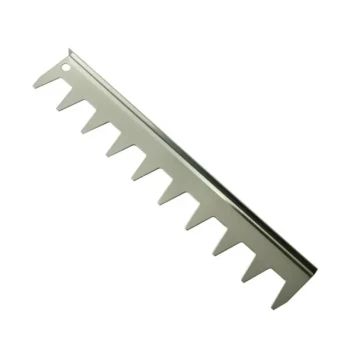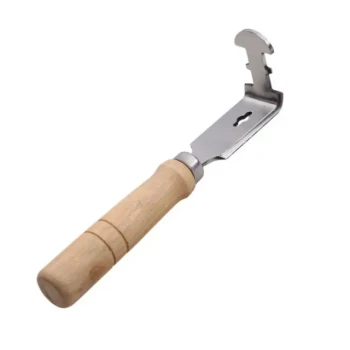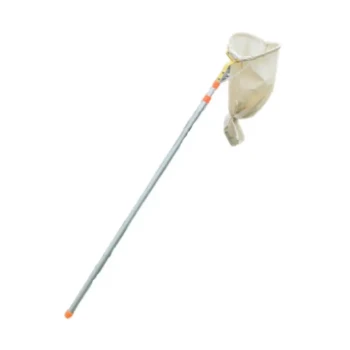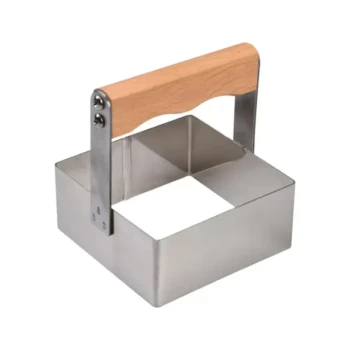The standard solution for soaking beehive frames after they have been physically cleaned is a mixture of bleach and water. This sanitization bath typically uses a ratio of one part household bleach to five parts water. Its primary purpose is to disinfect the equipment by killing microscopic pathogens and destroying any lingering pest eggs that survived the initial scraping and cleaning process.
The core principle is that physical cleaning removes visible debris, while a bleach soak provides chemical sanitization. This is a critical biosecurity step to prevent the transfer of invisible diseases and pests from one bee colony to another when reusing equipment.
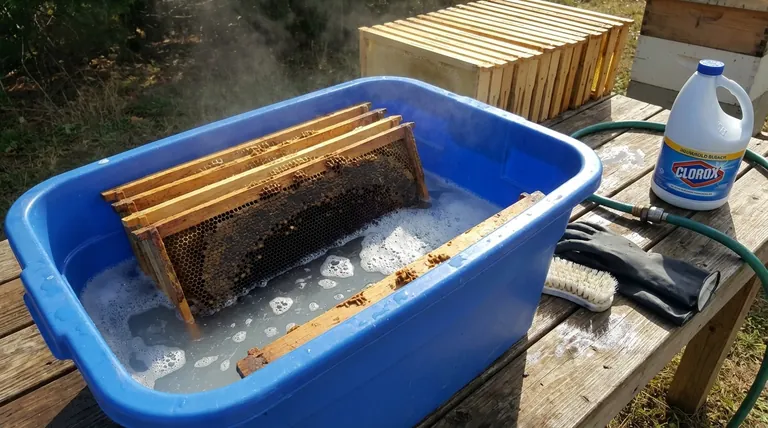
The "Why" Behind Soaking: A Deeper Look at Sanitization
Simply scraping a frame clean isn't enough to ensure it's safe for a new colony. The real threat often lies in microscopic organisms that can devastate a hive.
Eliminating Microscopic Pathogens
Used frames can harbor a host of bacteria, fungi, and viral particles. A bleach soak is effective at neutralizing common bee diseases that can linger on woodenware and drawn comb. This chemical disinfection is a key tool in preventing the spread of infections throughout an apiary.
Destroying Wayward Pest Eggs
Pests like wax moths and small hive beetles lay tiny eggs in the crevices of frames and comb. These eggs can easily survive a simple physical cleaning. Submerging the frames in the bleach solution effectively kills these eggs, preventing a future infestation from taking hold in the new colony that will occupy the equipment.
How Bleach Achieves Sanitization
The active ingredient in bleach, sodium hypochlorite, is a powerful oxidizing agent. It works by denaturing the proteins and destroying the cellular structures of microorganisms, rendering them harmless. This chemical action is what makes it a more reliable disinfectant than soap and water alone.
Key Steps in the Sanitization Process
Following a precise process is crucial for effective sanitization without harming your bees or damaging your equipment.
Step 1: Prepare the Solution
First, ensure the frames are thoroughly scraped and cleaned of all wax, propolis, and debris. Then, in a container large enough to fully submerge the frames, mix your solution using a strict ratio of 1 part bleach to 5 parts water.
Step 2: Soak for the Right Duration
Completely submerge the cleaned frames in the solution. A common practice is to soak them for approximately 20-30 minutes. This provides enough time for the bleach to effectively neutralize pathogens and pest eggs.
Step 3: Rinse Thoroughly
This step is absolutely critical. After soaking, you must rinse the frames extensively with clean water. Any residual bleach left on the equipment is toxic to bees and can harm or kill the colony.
Step 4: Air Dry Completely
Place the frames in a well-ventilated area, preferably in direct sunlight, and allow them to dry completely. This ensures all water has evaporated and helps dissipate any final traces of chlorine gas before the frames are returned to service.
Understanding the Trade-offs and Risks
While effective, using a bleach solution is not without its considerations. Understanding the potential downsides is part of responsible beekeeping.
It's a Preventative, Not a Cure-All
A bleach soak is an excellent preventative measure for general hygiene. However, for highly persistent and virulent diseases like American Foulbrood (AFB), whose spores are notoriously difficult to kill, most bee inspectors and apiary guidelines recommend burning the infected frames as the only truly safe option.
Potential for Equipment Damage
Bleach is a corrosive chemical. Over time, repeated or prolonged soaking can degrade the wood fibers of your frames. It can also cause rust on any metal components, such as frame wire or eyelets.
Risk of Bee Toxicity
The importance of the rinsing and drying steps cannot be overstated. Failure to completely remove the bleach residue will introduce a potent toxin directly into your hive, which can lead to a weakened or dead colony.
Applying This to Your Apiary Management
Your approach to sanitization should align with your specific situation and goals.
- If your primary focus is reusing frames from a healthy, recently defunct colony: A 1:5 bleach soak is an excellent and sufficient biosecurity step to ensure a clean start for a new hive.
- If your primary focus is incorporating used equipment from an unknown source: This sanitization process is non-negotiable. It is your single best defense against unknowingly introducing pests and diseases into your apiary.
- If your primary focus is dealing with a suspected or confirmed AFB infection: Do not rely on soaking. Immediately contact your local apiary inspector for guidance and follow established protocols, which almost always involve destroying the contaminated frames.
Proper equipment sanitization is a cornerstone of responsible beekeeping, directly protecting the health of your bees and the viability of your apiary.
Summary Table:
| Aspect | Key Detail |
|---|---|
| Standard Solution | 1 part household bleach to 5 parts water |
| Primary Purpose | Disinfect frames by killing microscopic pathogens and pest eggs |
| Soak Duration | 20-30 minutes |
| Critical Step | Thorough rinsing with clean water to remove toxic bleach residue |
| Final Step | Air dry completely in sunlight before reuse |
Protect Your Apiary with Professional-Grade Equipment
Proper sanitization is critical, but it starts with durable, high-quality frames and equipment. HONESTBEE supplies commercial apiaries and beekeeping equipment distributors with the robust, reliable supplies needed to maintain a healthy and productive operation.
Let us help you build a stronger foundation for your beekeeping business. Contact HONESTBEE today to discuss your wholesale needs and discover how our equipment supports superior hive management and biosecurity.
Visual Guide
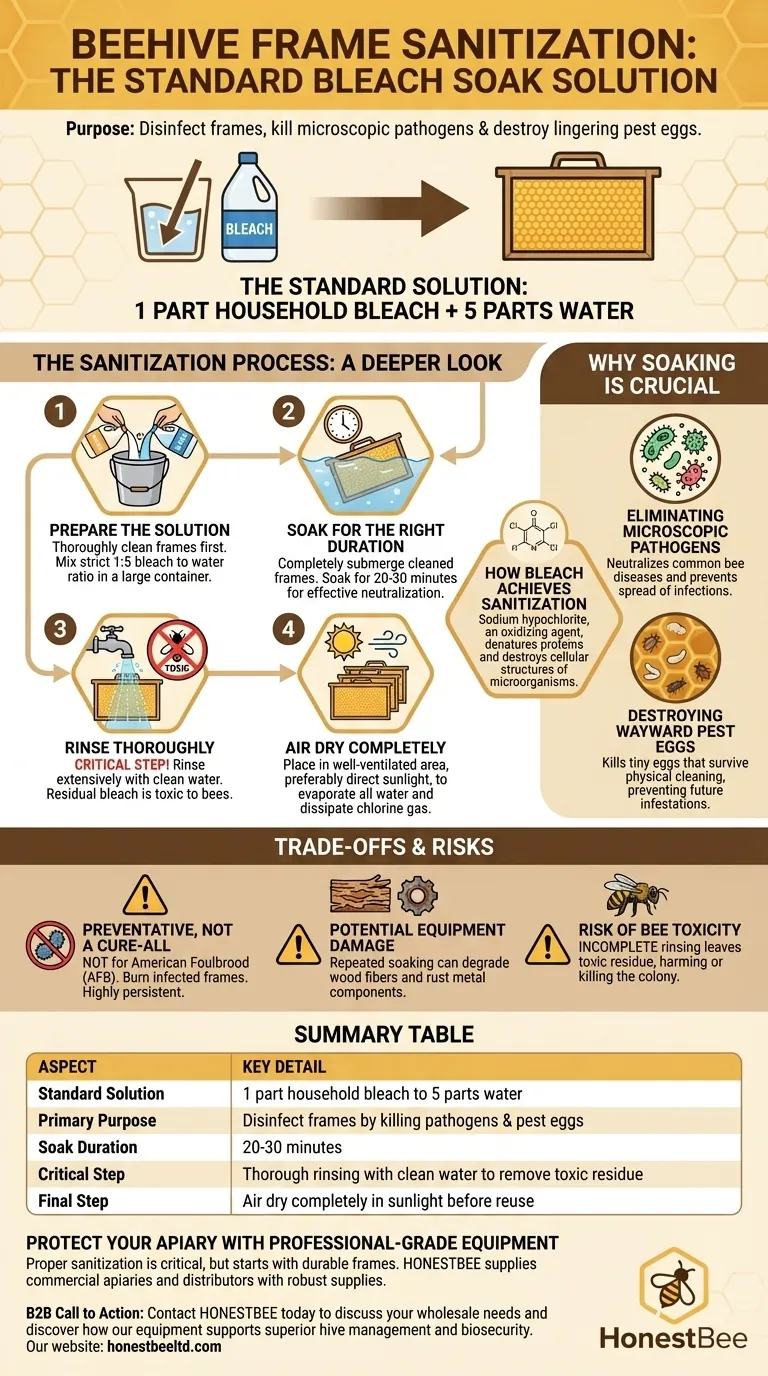
Related Products
- Professional Galvanized Hive Strap with Secure Locking Buckle for Beekeeping
- Stainless Steel 9 Frame Hive Spacer Durable Precise for Commercial Beekeeping
- Stainless Steel Honey Bee Smoker Hive and Honeycomb Smoker for Beekeeping
- Professional Stainless Steel Frame Cleaner with Ergonomic Wood Handle
- Premium Traditional Copper Bee Smoker with Bellows
People Also Ask
- Why are hive straps important for beekeepers? Secure Your Hives Against Wind, Predators & Transport
- What are the two styles of hive straps? Choose the Right Strap for Your Hive Security
- How should a cam buckle strap be installed for optimal performance? Master the Leverage for Maximum Tension
- What is the advantage of using cam buckle straps? Secure Your Load Fast with Simple, Safe Tensioning
- What is the best length for straps used around beehives? Why 12 Feet is the Industry Standard

